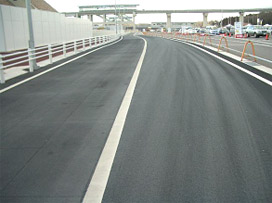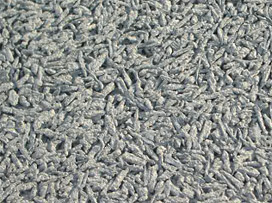Low-noise pavement made of recycled tires
- West Terminal -
Many of you have no doubt often seen waste tires used as play equipment and flowerbed fences in the parks. In fact, more than 1 million tons of waste tires (approx. 100 million tires) are generated annually in Japan. Of these tires, nearly 90% have been reused as fuel for cement manufacturing and iron-making (thermal recycling), or as fish banks and bases for tire retreads (material recycling). However, the remaining 10% of waste tires have not found applications; therefore people engaged in related industries have sought ways to effectively reuse these tires.
EXPO 2005 Aichi, Japan has pushed forward with environmental protection initiatives based on the concept of the 3Rs (Reduce, Reuse, and Recycle waste); the Exhibition site and pavillions have been constructed in line with this concept. In addition, many projects are under way to perform varioius demonstration experiments at the EXPO site, with the aim of verifying the feasibility of 3Rs initiatives for the future. One such project is the experiment on effective use of waste tires as roadbed material.

Porous elastic road surface

Enlargement of road surface (rubber chips seen as narrow, long pieces)
At a corner of the West Terminal, which is an operation base for shuttle buses and group buses that transport visitors to the Exhibition site, you will find that part of the pavement is darker than the area surrounding it. This is where the experiment is being carried out.
Speaking of “pavement,” many people only imagine an asphalt road surface built with crushed stones. Such conventional asphalt pavement has been referred in Japan to as “dense pavement.” If there is a depression on its surface, a puddle forms there whenever it rains, since asphalt pavement is not water permeable. In recent years, however, “drainage pavement” with an improved drainage function has been in widespread use. Also, a new type of pavement called “porous elastic road surface (PERS)” has been developed, in which rubber chips are used instead of crushed stones. PERS and drainage pavement are used for part of the road (approx. 100 m) on the parking side in the southern portion of the West Terminal. PERS, an effective application of waste tires, is created by mixing in rubber chips made from crushed waste tires. In addition, PERS has many other features, including drainage, noise reduction, shock-absorbency and freeze prevention.
This demonstration experiment seeks to verify not only the durability and reliability of the roadbed, but also the environmental performance of PERS, such as its effects in reducing the noise and vibration experienced by people in the surrounding area. In particular, the experimenters expect that the use of PERS will enable reduction of the noise level by 6 - 10 dB, compared with conventional asphalt pavement. This reduction is equivalent to the effect obtained when vehicle traffic is decreased to between one-fourth and one-tenth of the current volume.
Since this experiment is being conducted within the area of the West Terminal, unfortunately not all visitors can observe it. However, we hope that visitors who use the West Terminal will visit and see the PERS.
Thermal recycling and material recycling
Thermal recycling is the recovery of thermal energy produced when waste is incinerated. Well-known applications include air conditioning and heating, and heated swimming pools. Material recycling is the reuse of waste as raw material to create new products. Examples include the use of waste tires to build pavement and the use of recycled ceramics to make new products.


